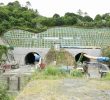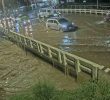Bernadita Guay said her husband now has almost lost the will to start back to square one. “Nadiscourage na gyud akong bana kung mag-uma pa ba kuno siya o dili na (My husband is at a loss whether he would go back to farming or not),” Guay said. Right now, she said, they are thinking of scraping gold dust from the riverside just to find money.
By CHARISSE LISONDRA & MARIETA BASTE-HERNANI/Correspondents
Davao Today
COMPOSTELA, Compostela Valley, Philippines — With nothing left but clothes on their backs, residents of this typhoon-wrecked town are at a loss on how to start with their lives anew, Davao Today learned during a relief mission sponsored by the nongovernmental Balsa Mindanao, Saturday at Ngan village, this town.
“Nahurot gyud, wala na gyuy nabilin (Everything is gone, nothing is left),” Bernadita Guay, 48, a resident of Ngan village whose family’s 3.7-hectare piece of land planted with coconut, mangosteen and root crops were wiped out by typhoon Pablo.
Guay also said it was unfair for the government to blame farmers like them for the illegal logging that had worsened the effects of typhoon Pablo.
“Tuod man, nangahoykahoy mi pero wala man mi nagpasagad. Dili pud mapasanginlan nga naupaw na nang bukid, kay gikan namo pagpuyo diri, daan na gyud nang upaw sukad nihawa ang Valderama, (Although we cut trees when we need to, but we never overdo it. We should not be blamed for denuding the forests, because since we lived here, the forests have already been cut down by the Valderrama Company before they left),” Guay said.
Like Guay, Eduardo Mansares, 60, faces a dilemma on surviving. His 1.5-hectare lot that was planted with corn, coconut and bananas was destroyed by the typhoon. The typhoon left some 20 coconut trees standing, but nothing of the cornfield that he was counting on for daily consumption.
Mansanares said he was alone in his house when typhoon struck. The gushing floodwaters plugged his exits. Good thing, he said, his house has a concrete base. But the roofing of his house was easily destroyed by the strong winds.
Scraping gold dust
Guay said her husband had almost lost the will to start back to square one.
“Nadiscourage na gyud akong bana kung mag-uma pa ba kuno siya o dili na (My husband is at a loss whether he would go back to farming or not),” Guay said. Right now, she said, they are thinking of scraping gold dust from the riverside just to find money.
As growing coconuts and fruit trees would take years, Guay does not know where to get her family’s next meal. She could not even buy medicines for her granddaughter who got sick of diarrhea.
“Gipangitaan na lang namo og udlot sa bayabas kay wala gyud mi ikapalit tambal (We just made do with a guava sap for medicine because we really have nothing to buy one),” she said.
Borrowing money is out of the question, too. “Dili baya ta makadali-dali sa mga tawo nga wa tay i-garantiya nga mga hayop (It is not easy to get loans especially if you do not have any farm animals as collateral),” Guay said that even the pigs and chickens have been swept out by the flood.
Despite the loss, Guay said, what was most important is that no one in the family is sick. But with no roof above their heads and no spare clothing (they are still wearing clothes picked from the debris in the typhoon’s aftermath), Guay feared failing health might happen.
When she lined up at the village hall, Guay anticipated they could get some nails so that they can start rebuilding their houses.
Unexpected
Guay said no one expected Typhoon Pablo to hit their province, which was hit with the storm for the first time.
The winds were so strong that it knocked coconut palms to the ground, she said. Her family was lucky to have been able to flee to a mountainous part of the village, where they spent the night in the aftermath of the typhoon sleeping on the ground.
“Nangatulog ra mi nga walay banig, wala tanan. Tapot lawas, basa. Nauga na lang among gisuot nga sanina sa among lawas nga walay ilis-ilis, (We just slept without any covering on the floor, there was nothing, we slept even with our wet clothes on. They just dried up as we wear them because we have nothing else to change to),” recounted Guay.
“Nanglung-ag mi sa among bugas didto sa bukid nga basa kaayo. Dili na gud angay kaonon kay magdaot among tiyan. Niingon na lang ko sa akong mga anak nga kaon na lang para makasustiner lang gyud (We cooked rice that was wet and almost spoiled. I told my kids to just try to eat and not mind it as long as there was something to get by),” she added.
Their neighbor however, was not as lucky. A coconut tree fell on their house, which killed one member of the family.
For Mansares, he recalled the sudden impact of the typhoon. “Pagkusog sa bagyo wa nay atop akong balay. Pagka taud-taud nitaas naman pud ang tubig. Pirteng dakoa na sa tubig (When the storm turned for the worse, my roof was gone. Later the water rose and swelled,” Mansanares said. He said all his things were washed out by the flood.
“Sa akong gibutangan abi kog dili maabot sa tubig, naabot paman gyud. Wala nako kadala og gamit sa taas kay ning naog nako kay ang sin nagsige na mag kalangkat. Mao tong pagkalangkat, baba napud ko. Didto lang ko sa ubos pud. Sa hagdan. Kay dili naman ko makanaog sa ubos gyud kay perti naman ka kusog sa tubig. Ang sira pud dili napud ma-abre, (I thought the flood would never reached my house, but it did. I did not get to bring anything upstairs. When the roof was tearing off, I went down of my house, but I stayed in the stairs because the water was rushing in and I cannot open the door),” Mansanares recounted his experience.
The water he said came from the mountains. Usually, the school would get flooded but he did not expect the water to reach the level of his house. Two other nearby houses were swept off by the gushing waters while another two houses of his neighbors were completely torn down.
“Ang akong giproblemahan kay ang atop. Kay malata man ang salog gud kung dili maatopan. Dili na magsilbi akong sin kay napilo-pilo naman (I worry now that I need to get a roof. The floor would rot away if the house has no roofing, the old aluminum roof was destroyed),” he said.
As of December 6, 237 villages from the 11 municipalities of Compostela Valley province were affected involving 127,471 families or 637,366 individuals. There were 322 recovered bodies while 169 were still missing. A total of 592 individuals were injured.
Relief mission
Of the relief mission, Mansanares said “Nalipay ko sa akong nadawat. Pag-ingon sa akong silingan nga naay panghatag rasyon, adtu dayon ko. Nahatagan dayon ko kay naa man sa listahan. Natawag dayon ko (I am glad with I received. When my neighbor said there were rations given out, I went there right away. My name was on the list so I got my ration right away),” Mansanares said.
He said he hopes the government would give them attention. “Sukad sa panghitabo, duha ka kilo ra gyud nga bugas ang nahatag sa gobyerno sa amo (since this happened, the government has only given us two kilos of rice),” Mansanares said.
Since the tragedy struck, Guay said all they got from government authorities were two kilos of rice. She was thankful she received some goods distributed Saturday by Balsa Mindanao.
Even the organizers of the relief mission admitted that the goods they mustered for distribution that day were not enough. (Charisse Lisondra, Marieta Baste-Hernani, davaotoday.com)










